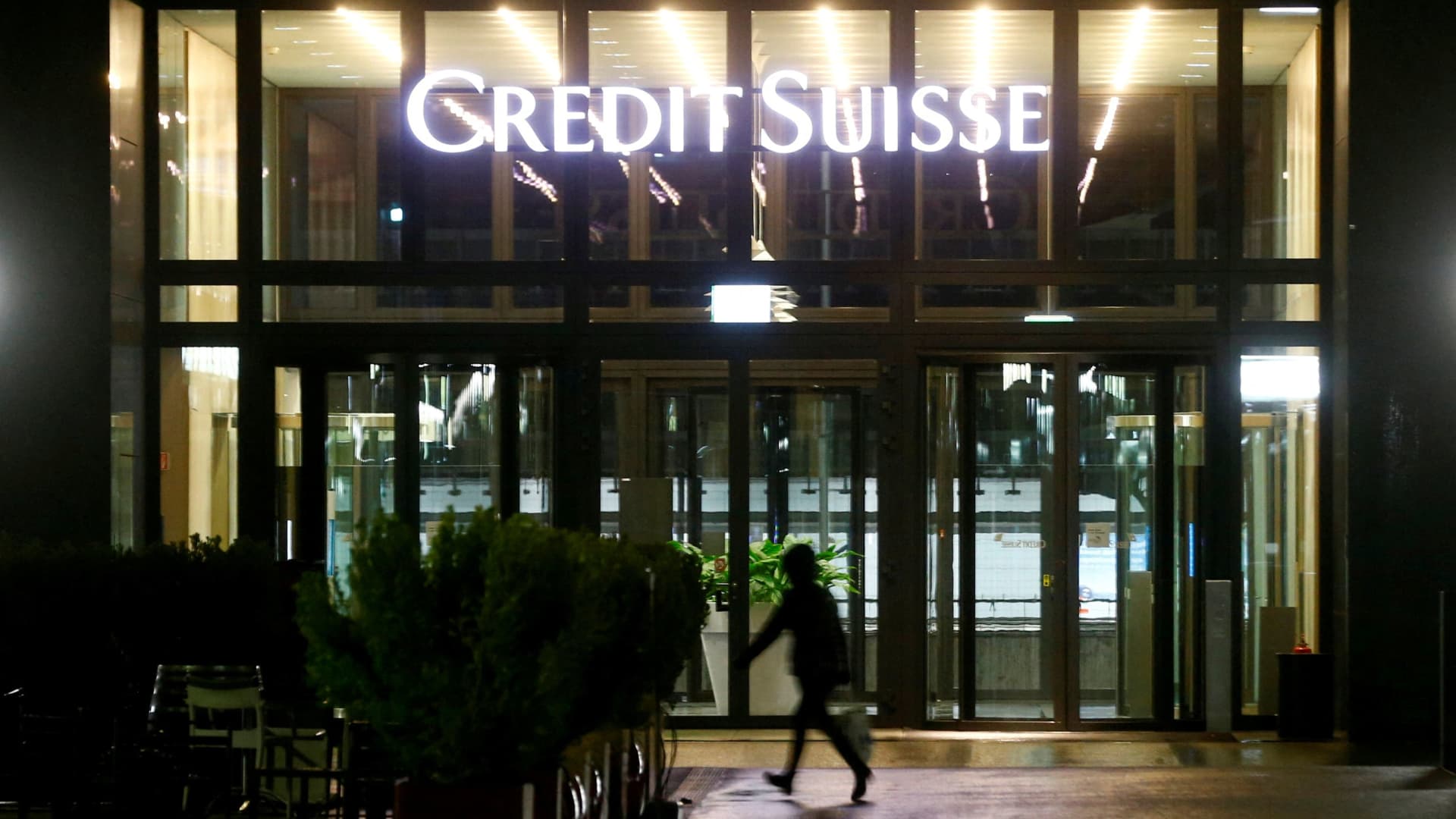From spying to Swiss bailout: How years of turbulence at Credit Suisse came to a head

The logo of Swiss bank Credit Suisse is seen at an office building in Zurich, Switzerland February 21, 2022.
Arnd Wiegmann | Reuters
Credit Suisse received a liquidity lifeline from the Swiss National Bank this week after its share price plunged to an all-time low, but the embattled lender’s path to the brink has been a long and tumultuous one.
The announcement that Credit Suisse would borrow up to 50 billion Swiss francs ($54 billion) from the central bank came after consecutive sessions of steep drops in its share price. It made Credit Suisse the first major bank to receive such an intervention since the 2008 Global Financial Crisis.
related investing news
The bank’s shares ended Wednesday at 1.697 Swiss francs — down almost 98% from the stock’s all-time high in April 2007, while credit default swaps, which insure bondholders against a company defaulting, soared to new record highs this week.
It comes after years of investment banking underperformance and a litany of scandals and risk management failures.
Scandals
Credit Suisse is currently undergoing a massive strategic overhaul in a bid to address these chronic issues. Current CEO and Credit Suisse veteran Ulrich Koerner took over from Thomas Gottstein in July, as poor investment bank performance and mounting litigation provisions continued to hammer earnings.
Gottstein took the reins in early 2020 following the resignation of predecessor Tidjane Thiam in the wake of a bizarre spying scandal, in which UBS-bound former wealth management boss Iqbal Khan was tailed by private contractors allegedly at the direction of former COO Pierre-Olivier Bouee. The saga also saw the suicide of a private investigator and the resignations of a slew of executives.
The former head of Credit Suisse’s flagship domestic bank widely perceived as a steady hand, Gottstein sought to lay to rest an era plagued by scandal. That mission was short-lived.
In early 2021, he found himself dealing with the fallout from two huge crises. The bank’s exposure to the collapses of U.S. family hedge fund Archegos Capital and British supply chain finance firm Greensill Capital saddled it with massive litigation and reimbursement costs.
These oversight failures resulted in a massive shakeup of Credit Suisse’s investment banking, risk and compliance and asset management divisions.
In April 2021, former Lloyds Banking Group CEO Antonio Horta-Osorio was brought in to clean up the bank’s culture after the string of scandals, announcing a new strategy in November.
But in January 2022, Horta-Osorio was forced to resign after being found to have twice violated Covid-19 quarantine rules. He was replaced by UBS executive Axel Lehmann.
The bank began another costly sweeping transformation project as Koerner and Lehmann set out to return the embattled lender to long-term stability and profitability.
This included the spin-off of Credit Suisse’s investment banking division to form U.S.-based CS First Boston, a significant cut in exposure to risk-weighted assets and a $4.2 billion capital raise, which saw the Saudi National Bank take a 9.9% stake to become the largest shareholder.
March madness
Credit Suisse reported a full-year net loss of 7.3 billion Swiss francs for 2022, predicting another “substantial” loss in 2023 before returning to profitability in 2024.
Reports of liquidity concerns late in the year led to huge outflows of assets under management, which hit 110.5 billion Swiss francs in the fourth quarter.
After yet another sharp share price fall on the back of its annual results in early February, Credit Suisse shares entered March 2023 trading at a paltry 2.85 Swiss francs per share, but things were about to get worse still.
On March 9, the company was forced to delay its 2022 annual report after a late call from the U.S. Securities and Exchange Commission relating to a “technical assessment of previously disclosed revisions to the consolidated cash flow statements” in 2019 and 2020.
The report was eventually published the following Tuesday, and Credit Suisse noted that “material weaknesses” were found in its financial reporting processes for 2021 and 2022, though it confirmed that its previously announced financial statements were still accurate.
Having already suffered the global risk-off jolt resulting from the collapse of U.S.-based Silicon Valley Bank, the combination of these remarks and confirmation that outflows had not reversed compounded Credit Suisse’s share price losses.
And on Wednesday, it went into freefall, as top investor the Saudi National Bank said it was not able to provide any more cash to Credit Suisse due to regulatory restrictions. Despite the SNB clarifying that it still believed in the transformation project, shares dived 24% to an all-time low.
On Wednesday evening, Credit Suisse announced that it would exercise its option to borrow up to 50 billion Swiss francs from the Swiss National Bank under a covered loan facility and a short-term liquidity facility.
The Swiss National Bank and the Swiss Financial Market Supervisory Authority said in a statement Wednesday that Credit Suisse “meets the capital and liquidity requirements imposed on systemically important banks.”
The support from the central bank and reassurance on Credit Suisse’s financial position led to a 20% pop in the share price on Thursday, and may have reassured depositors for now.
However, analysts suggest questions will remain as to where the market will place the stock’s true value for shareholders in the absence of this buffer from the Swiss authorities.









